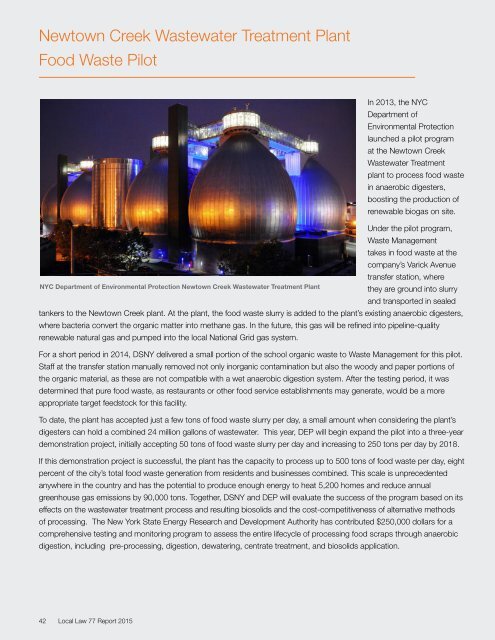2015 NYC Organics Collection Report
1jcwPY1
1jcwPY1
You also want an ePaper? Increase the reach of your titles
YUMPU automatically turns print PDFs into web optimized ePapers that Google loves.
Newtown Creek Wastewater Treatment Plant<br />
Food Waste Pilot<br />
In 2013, the <strong>NYC</strong><br />
Department of<br />
Environmental Protection<br />
launched a pilot program<br />
at the Newtown Creek<br />
Wastewater Treatment<br />
plant to process food waste<br />
in anaerobic digesters,<br />
boosting the production of<br />
renewable biogas on site.<br />
Under the pilot program,<br />
Waste Management<br />
takes in food waste at the<br />
company’s Varick Avenue<br />
transfer station, where<br />
<strong>NYC</strong> Department of Environmental Protection Newtown Creek Wastewater Treatment Plant<br />
they are ground into slurry<br />
and transported in sealed<br />
tankers to the Newtown Creek plant. At the plant, the food waste slurry is added to the plant’s existing anaerobic digesters,<br />
where bacteria convert the organic matter into methane gas. In the future, this gas will be refined into pipeline-quality<br />
renewable natural gas and pumped into the local National Grid gas system.<br />
For a short period in 2014, DSNY delivered a small portion of the school organic waste to Waste Management for this pilot.<br />
Staff at the transfer station manually removed not only inorganic contamination but also the woody and paper portions of<br />
the organic material, as these are not compatible with a wet anaerobic digestion system. After the testing period, it was<br />
determined that pure food waste, as restaurants or other food service establishments may generate, would be a more<br />
appropriate target feedstock for this facility.<br />
To date, the plant has accepted just a few tons of food waste slurry per day, a small amount when considering the plant’s<br />
digesters can hold a combined 24 million gallons of wastewater. This year, DEP will begin expand the pilot into a three-year<br />
demonstration project, initially accepting 50 tons of food waste slurry per day and increasing to 250 tons per day by 2018.<br />
If this demonstration project is successful, the plant has the capacity to process up to 500 tons of food waste per day, eight<br />
percent of the city’s total food waste generation from residents and businesses combined. This scale is unprecedented<br />
anywhere in the country and has the potential to produce enough energy to heat 5,200 homes and reduce annual<br />
greenhouse gas emissions by 90,000 tons. Together, DSNY and DEP will evaluate the success of the program based on its<br />
effects on the wastewater treatment process and resulting biosolids and the cost-competitiveness of alternative methods<br />
of processing. The New York State Energy Research and Development Authority has contributed $250,000 dollars for a<br />
comprehensive testing and monitoring program to assess the entire lifecycle of processing food scraps through anaerobic<br />
digestion, including pre-processing, digestion, dewatering, centrate treatment, and biosolids application.<br />
42 Local Law 77 <strong>Report</strong> <strong>2015</strong>


